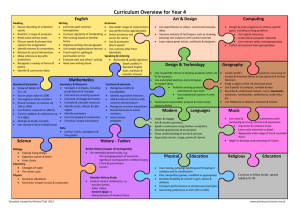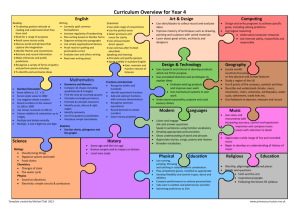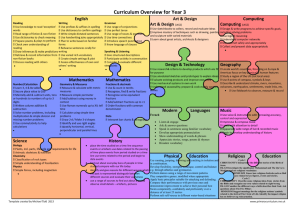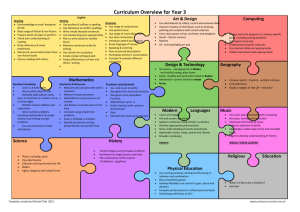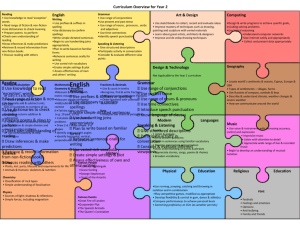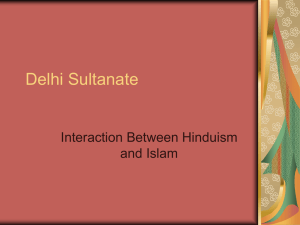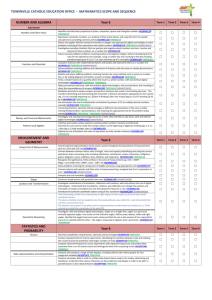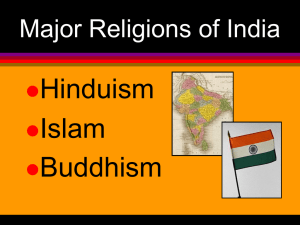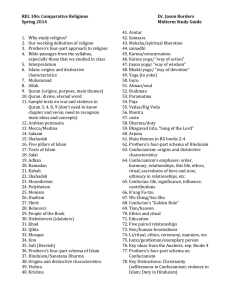Y4 Curriculum Overview (docx file)
advertisement
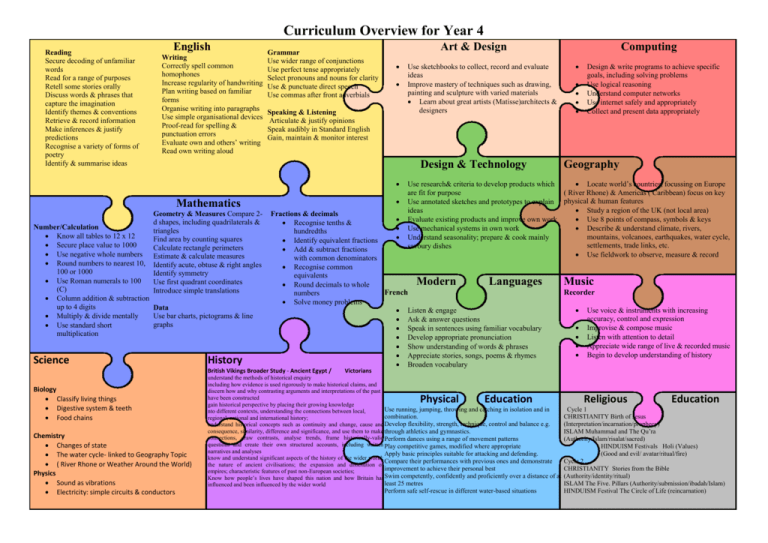
Curriculum Overview for Year 4 Reading Secure decoding of unfamiliar words Read for a range of purposes Retell some stories orally Discuss words & phrases that capture the imagination Identify themes & conventions Retrieve & record information Make inferences & justify predictions Recognise a variety of forms of poetry Identify & summarise ideas English Grammar Writing Use wider range of conjunctions Correctly spell common Use perfect tense appropriately homophones Select pronouns and nouns for clarity Increase regularity of handwriting Use & punctuate direct speech Plan writing based on familiar Use commas after front adverbials forms Organise writing into paragraphs Speaking & Listening Use simple organisational devices Articulate & justify opinions Proof-read for spelling & Speak audibly in Standard English punctuation errors Gain, maintain & monitor interest Evaluate own and others’ writing Read own writing aloud Art & Design Use sketchbooks to collect, record and evaluate ideas Improve mastery of techniques such as drawing, painting and sculpture with varied materials Learn about great artists (Matisse)architects & designers Design & Technology Mathematics Geometry & Measures Compare 2d shapes, including quadrilaterals & triangles Find area by counting squares Calculate rectangle perimeters Estimate & calculate measures Identify acute, obtuse & right angles Identify symmetry Use first quadrant coordinates Introduce simple translations Number/Calculation Know all tables to 12 x 12 Secure place value to 1000 Use negative whole numbers Round numbers to nearest 10, 100 or 1000 Use Roman numerals to 100 (C) Column addition & subtraction up to 4 digits Data Use bar charts, pictograms & line Multiply & divide mentally graphs Use standard short multiplication Science History Biology Classify living things Digestive system & teeth Food chains Chemistry Changes of state The water cycle- linked to Geography Topic ( River Rhone or Weather Around the World) Physics Sound as vibrations Electricity: simple circuits & conductors Design & write programs to achieve specific goals, including solving problems Use logical reasoning Understand computer networks Use internet safely and appropriately Collect and present data appropriately Geography Use research& criteria to develop products which Locate world’s countries, focussing on Europe are fit for purpose ( River Rhone) & Americas ( Caribbean) focus on key Use annotated sketches and prototypes to explain physical & human features ideas Study a region of the UK (not local area) Evaluate existing products and improve own work Use 8 points of compass, symbols & keys Use mechanical systems in own work Describe & understand climate, rivers, mountains, volcanoes, earthquakes, water cycle, Understand seasonality; prepare & cook mainly settlements, trade links, etc. savoury dishes Use fieldwork to observe, measure & record Fractions & decimals Recognise tenths & hundredths Identify equivalent fractions Add & subtract fractions with common denominators Recognise common equivalents Modern Languages Round decimals to whole French numbers Solve money problems Listen & engage Ask & answer questions Speak in sentences using familiar vocabulary Develop appropriate pronunciation Show understanding of words & phrases Appreciate stories, songs, poems & rhymes Broaden vocabulary British Vikings Broader Study - Ancient Egypt / Computing Music Recorder Use voice & instruments with increasing accuracy, control and expression Improvise & compose music Listen with attention to detail Appreciate wide range of live & recorded music Begin to develop understanding of history Victorians understand the methods of historical enquiry including how evidence is used rigorously to make historical claims, and discern how and why contrasting arguments and interpretations of the past have been constructed gain historical perspective by placing their growing knowledge Use running, jumping, throwing and catching in isolation and in nto different contexts, understanding the connections between local, combination. regional, national and international history; understand historical concepts such as continuity and change, cause and Develop flexibility, strength, technique, control and balance e.g. consequence, similarity, difference and significance, and use them to make through athletics and gymnastics. connections, draw contrasts, analyse trends, frame historically-valid Perform dances using a range of movement patterns questions and create their own structured accounts, including written Play competitive games, modified where appropriate narratives and analyses Apply basic principles suitable for attacking and defending. know and understand significant aspects of the history of the wider world: Compare their performances with previous ones and demonstrate the nature of ancient civilisations; the expansion and dissolution of improvement to achieve their personal best empires; characteristic features of past non-European societies; Know how people’s lives have shaped this nation and how Britain has Swim competently, confidently and proficiently over a distance of at least 25 metres influenced and been influenced by the wider world Physical Education Perform safe self-rescue in different water-based situations Religious Education Cycle 1 CHRISTIANITY Birth of Jesus (Interpretation/incarnation/prophecy) ISLAM Muhammad and The Qu’ra (Authority/Islam/risalat/sacred) HINDUISM Festivals Holi (Values) (Good and evil/ avatar/ritual/fire) Cycle 2 CHRISTIANITY Stories from the Bible (Authority/identity/ritual) ISLAM The Five. Pillars (Authority/submission/ibadah/Islam) HINDUISM Festival The Circle of Life (reincarnation)
